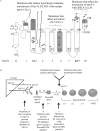Role of apolipoproteins, ABCA1 and LCAT in the biogenesis of normal and aberrant high density lipoproteins
- PMID: 29109329
- PMCID: PMC6307667
- DOI: 10.7555/JBR.31.20160082
Role of apolipoproteins, ABCA1 and LCAT in the biogenesis of normal and aberrant high density lipoproteins
Abstract
In this review, we focus on the pathway of biogenesis of HDL, the essential role of apoA-I, ATP binding cassette transporter A1 (ABCA1), and lecithin: cholesterol acyltransferase (LCAT) in the formation of plasma HDL; the generation of aberrant forms of HDL containing mutant apoA-I forms and the role of apoA-IV and apoE in the formation of distinct HDL subpopulations. The biogenesis of HDL requires functional interactions of the ABCA1 with apoA-I (and to a lesser extent with apoE and apoA-IV) and subsequent interactions of the nascent HDL species thus formed with LCAT. Mutations in apoA-I, ABCA1 and LCAT either prevent or impair the formation of HDL and may also affect the functionality of the HDL species formed. Emphasis is placed on three categories of apoA-I mutations. The first category describes a unique bio-engineered apoA-I mutation that disrupts interactions between apoA-I and ABCA1 and generates aberrant preβ HDL subpopulations that cannot be converted efficiently to α subpopulations by LCAT. The second category describes natural and bio-engineered apoA-I mutations that generate preβ and small size α4 HDL subpopulations, and are associated with low plasma HDL levels. These phenotypes can be corrected by excess LCAT. The third category describes bio-engineered apoA-I mutations that induce hypertriglyceridemia that can be corrected by excess lipoprotein lipase and also have defective maturation of HDL. The HDL phenotypes described here may serve in the future for diagnosis, prognoses and potential treatment of abnormalities that affect the biogenesis and functionality of HDL.
Figures





References
-
- Zannis VI, Cole FS, Jackson CL, et al. Distribution of apolipoprotein A-I, C-II, C-III, and E mRNA in fetal human tissues. Time-dependent induction of apolipoprotein E mRNA by cultures of human monocyte-macrophages[J].Biochemistry, 1985,24(16):4450–4455. - PubMed
-
- Zannis VI, Chroni A, Krieger M. Role of apoA-I, ABCA1, LCAT, and SR-BI in the biogenesis of HDL[J].J Mol Med (Berl), 2006,84(4):276–294. - PubMed
-
- Daniil G, Phedonos AA, Holleboom AG, et al. Characterization of antioxidant/anti-inflammatory properties and apoA-I-containing subpopulations of HDL from family subjects with monogenic low HDL disorders[J].Clin Chim Acta, 2011,412(13-14):1213–1220. - PubMed
-
- Sundaram M, Yao Z. Intrahepatic role of exchangeable apolipoproteins in lipoprotein assembly and secretion[J].Arterioscler Thromb Vasc Biol, 2012,32(5):1073–1078. - PubMed
LinkOut - more resources
Full Text Sources
Other Literature Sources
Miscellaneous

